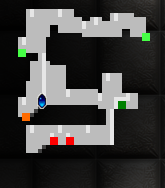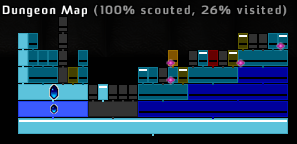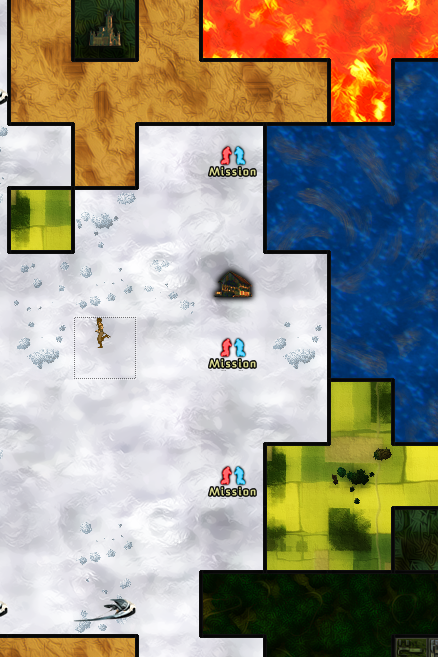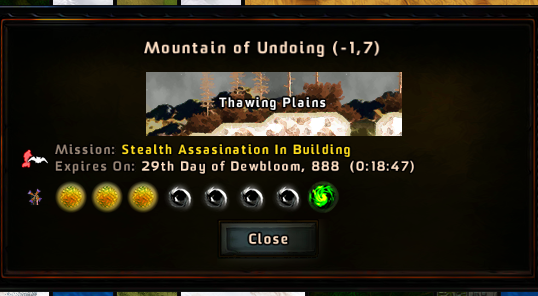Valley 1:What are all these maps for?
A Valley Without Wind offers a vast set of tools and maps to help you explore Environ in an efficient manner. This guide will help you to learn how to use these tools.
Contents
The Hierarchy Of The World
It's helpful to understand how the world is organized, and what terminology is used.
The World Itself
Each world of Environ is unique. You can call your world whatever you want in order to be able to find it when you have multiple worlds, but each one you create represents an alternate reality of a single world called "Environ." In AVWW, the world of Environ is infinite (or at least so unbounded that nobody could reach the end of it within a human lifespan).
Continents
The world is divided into continents. Each continent is being oppressed by an overlord and that overlord's lieutenants. Saving one continent by killing its overlord will reveal the next continent on the world map. Each continent functions as a "New Game+" option does in many other games: letting you carry forward your inventory, enchants and unlockables, but not your spells themselves.
Regions
Each tile on the world map is a region. With a very few exceptions (deep sea tiles and ports), any time you press the Confirm key on a region tile, you will enter the main side view action-adventure mode. A single region can be infinitely large thanks to its cave systems. Also it's worth noting that the main surface area of the region is really only a part of the region; when you do missions, you'll find yourself in parts of the region that are only accessible for the duration of that mission.
Dungeons
There are three kind of dungeons: surface/exterior, interior/building, and underground/cavern. It bothers some folks that we call the surface of a region a "dungeon," and certainly in the classical sense of the word that's a misnomer. But in the world of video games it's very fitting, especially considering the nature of our surface dungeons.
There is typically only one surface dungeon in a region, although when you enter missions you may find yourself having access to other, smaller surface dungeons temporarily. Each building you encounter, whether on the surface or underground, has a single interior dungeon contained within it. And each cave system that you enter is one underground dungeon; but most underground dungeons also contain a link down to a deeper underground dungeon (with tougher monsters, by the by).
Chunks/Rooms/Nodes
The actual area you are in when you are wandering around in side view is known as a chunk, because it represents either a chunk of an exterior environment, a chunk of an underground cave, or a room in a building. In buildings we tend to just call them rooms, but sometimes when referring to the dungeon map we refer to them as nodes in the map. Sorry about any confusion there.
Chunk Map (aka, Minimap)
Use the minimap in the top left to get around when you are in a room, cave, or outdoor area.
-- Passages (doors, ventilation ducts, cave holes, etc) --
- Dark Green: Passages you've already been through
- Red: Passages you've not yet gone through.
-- Loot --
- Orange: Loot items such as platforms and scrolls.
- Light Green: Other types of loot such as Enchant Containers or Upgrade Stones.
-- Characters --
- Blue Crystal: Your position.
- Yellow Crystals: Positions of any other players.
- Skull Icons: Positions of any bosses.
Any greyed-out sections have not been explored, and will be revealed as you near them.
Dungeon Map
This map can be found in the bottom right corner of the screen. The term "dungeon" refers to a group of surface areas, the interior of any building, or a cluster of caverns.
While playing, you can hover over any part of the dungeon map for more information.
This map represents the relationship between rooms in buildings. Each rectangle is a room, and a rectangle directly above another means that there is a connection between them. A rectangle being above another one does not mean it is on a higher floor -- only that it is further from the entrance.
In buildings, the bottom-most node has an exit to the outside; in underground caverns it's always the top-most node; and in surface dungeons either the rightmost or leftmost node leads to the world map.
This is used to represent the relationship between rooms in a building. Each rectangle is a room. A rectangle directly above another means that there is a connection between the two rooms (usually a door). The diamond outline shows you what room you are currently in, a smaller, blinking diamond will appear on the map when you are standing in front of a door showing you the room that that door leads to. A rectangle being above another one does not necessarily indicate that it is on a higher floor, only that it is deeper into the building, the bottom-most room will most likely have a door to/from the outside.
The blue crystal shows you what room you are currently in. If you are standing next to a door, a smaller blue crystal will show you the room the door leads to.
Always be sure to hover over nodes to get details on what they contain, but each color has a different meaning:
- Teal: Regular rooms in buildings
- Dark Blue: Staircases up or down in buildings.
- Tan: Caverns
- Green: Surface areas
- Gold: Stash rooms, gem vein caverns, secret missions, and other stuff you want.
- Red: Regular boss fights.
- Purple: Overlord or lieutenant boss fights, or special areas in missions.
- Gray: Destroyed rooms that block your way but which you can otherwise ignore.
Other features of interest:
- Unvisited nodes are darker on the map, and have a black line through them.
- The white line towards the top of some nodes means they contain a secret passage to another node elsewhere on the map.
- The green/purple flashing icon in the bottom left of some nodes means they contain a warp gate.
Region Map
You can get a map of the entire region (which is, in turn, a single tile on the world map) by going into a warp gate. Inside a warp gate, this lets you open up the dungeon map for any part of the region you have previously visited, including other buildings, and then warp to any gate that you have previously visited.
There is also a keybind for showing this map at any time, but as that is not generally needed it is unbound by default.
- The blue squares represent buildings that you have been in.
- The green in the center represents the surface of the region.
- The gold at the bottom represents caves.
World Map
This is the overland map, it will not only show you the types of regions you can enter in your world, but it will let you know about the important features in each region.
For example, moving your character to one of the mission squares on the above map might bring up a box similar to the one below in the left hand corner of the screen, telling you all the information you need to know on the mission in that region. Even when no missions are available in that particular region, moving onto a particular square will reveal a lot of information to you that should be helpful.
What The Heck Kind Of Map Is That!? (Dungeon/Region Maps)
We get this reaction, sometimes, from folks who have never seen a graph-based representation of this kind of data. Here's the deal: we're representing a 3D building in 2D space, and some of these buildings can get quite large. So what you're seeing up there is technically a graph, not a map, in the mathematical sense.
Here's What The Graph-Style "Maps" Are Good At Showing You
A graph-style map is incredibly compact, and is excellent for showing you certain kinds of data that you need. Specifically:
- How rooms are connected to one another.
- Where cross-connections exist (the little white lines, with details when you hover over those nodes).
- Where you have been before (the lighter nodes).
- Where you have not been before (the darker nodes, with the black line through them).
- Where the exit from the building is.
- Which rooms/caverns have a lot of connections to sub-rooms/caverns ("child nodes," if you want to get all mathy about it).
Here's What The Graph-Style "Maps" Don't Show You At All
Despite their benefits, there are a few key things to understand about what a graph-style map does not tell you:
- The relative size of rooms/caves.
- Rooms that are "larger" in the graph simply have more children or grandchildren (or great-grandchildren, etc) under them.
- The relative position of rooms/caves.
- You can infer certain things about the position of rooms by looking at these graphs, but given that they are graphs you'll notice that -- for instance -- everything is oriented around the central entrance node. And so both "downstairs" and "upstairs" are relative to that node in a building, and both go upwards in the graph. You go down into the basement, or up into the second floor, and either way you move up in the graph. You go into the room next to the atrium on the first floor, you also go up in the graph.
- This throws some people for a loop at first, but it really is the most efficient way to represent the information -- and, we're convinced, actually the only way to represent it short of creating a 3D cube literal map that you could rotate around and look at. And if you've ever experienced those in other games (ahem), you'll know what an incredible pain those are to use.
- You can infer certain things about the position of rooms by looking at these graphs, but given that they are graphs you'll notice that -- for instance -- everything is oriented around the central entrance node. And so both "downstairs" and "upstairs" are relative to that node in a building, and both go upwards in the graph. You go down into the basement, or up into the second floor, and either way you move up in the graph. You go into the room next to the atrium on the first floor, you also go up in the graph.




